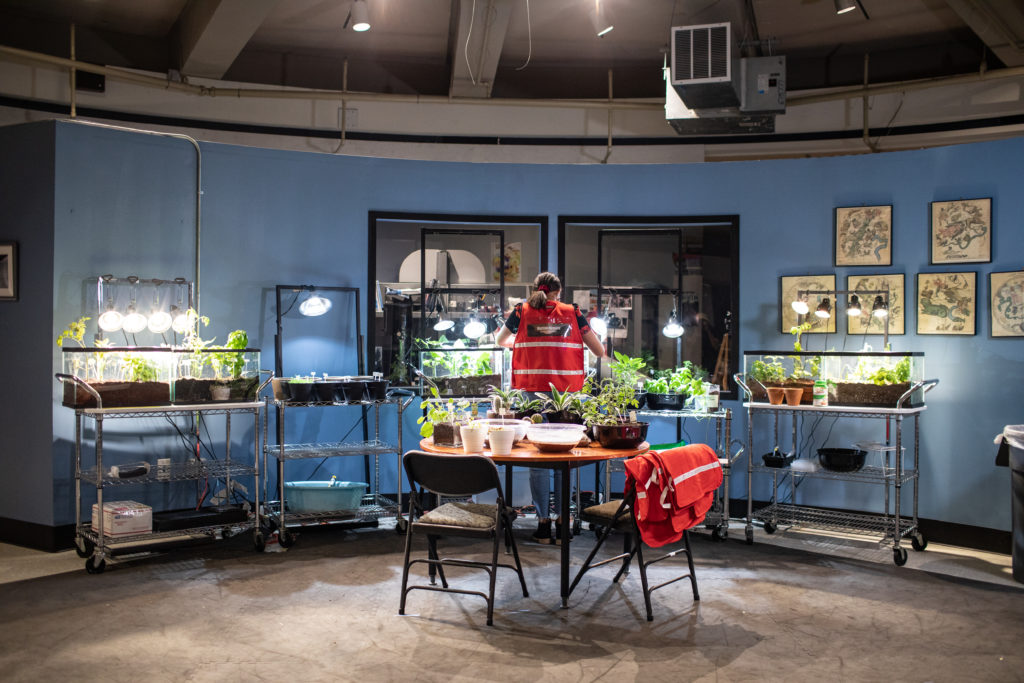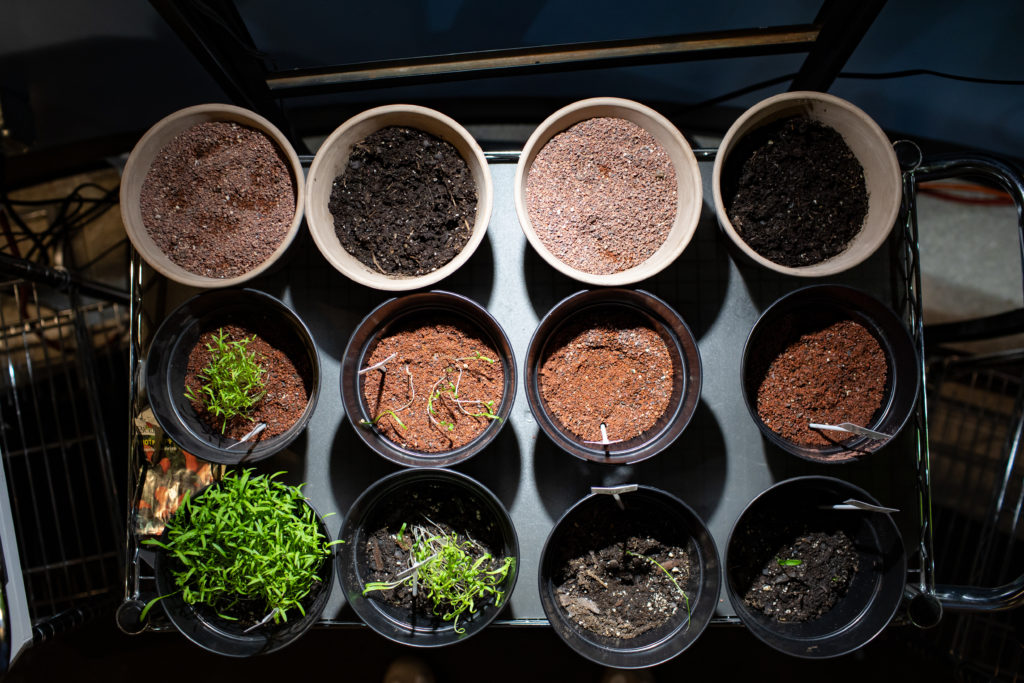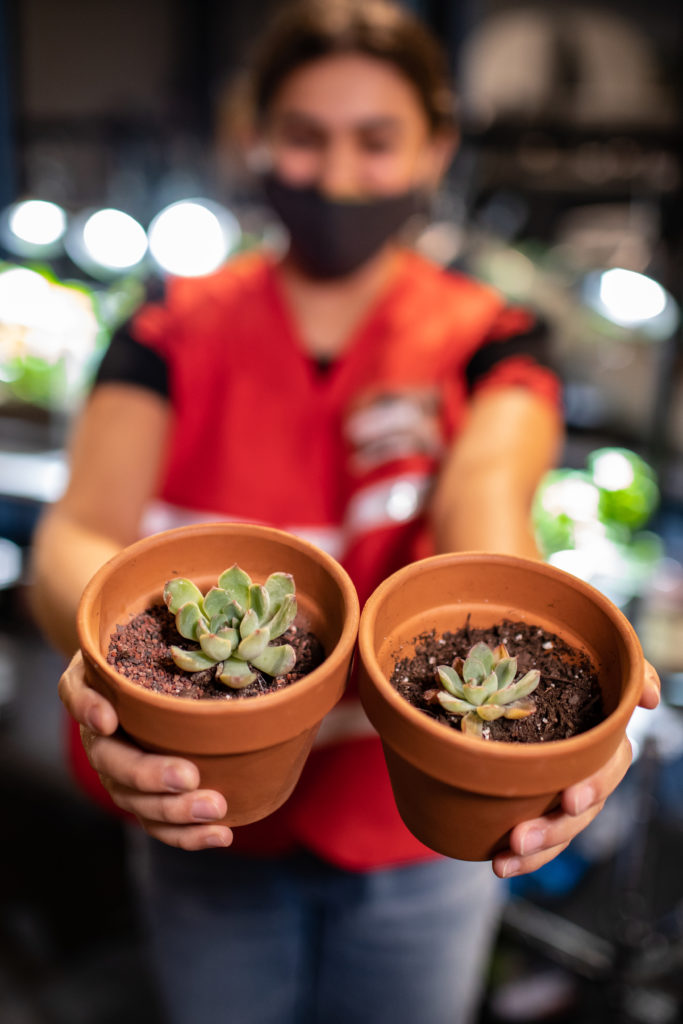As we prepared to suspend our newest celestial installation Mars by Luke Jerram in the Glassell Hall, summer interns in the museum’s astronomy department set up a Martian Farm. With the farm, interns are conducting experiments to determine how different plants react to Mars soil compared with Earth soil.

They planted different types of plants in Earth potting soil and in simulated Mars soil. Two similar plants of each species were chosen – one to be grown in Earth soil and one in Mars soil. Before planting, the Mars soil simulant was rinsed in water because it might contain perchlorates, which are toxic and make plants inedible. Sprouted plants were chosen to expedite the experiment, with most being food crops. All of the plants are watered once a week.
Tomatoes, yellow bell peppers, green okra and sweet basil, in that order, were planted in terrarium 1 with Earth soil and in terrarium 2 with Mars soil simulant. The yellow bell pepper has been thriving and seems equally healthy in the two soils. A few weeks into the experiment, we saw that the leaves of the green okra plant were turning yellow in both soils. Research indicates that lack of nitrogen in the soil can cause leaves to turn yellow.
The basil has not had any problems so far in either soil, but it seems to prefer the Earth soil by growing much taller as seen in the comparative photos above. The tomato plants did equally well in both of the soils, with one interesting result: a tomato appeared on the plant in the Mars soil!

We designed an experiment to address the yellowing of leaves in some of the plants, caused by a lack of nitrogen in the soil. We chose a soil additive called MPK or nitrogen, phosphorus and potassium. In terrariums 3 and 4, it was added to both soils since the elements were not found in the Mars soil simulant and were scarce in the Earth soil. Four types of plants were set in each soil: sweet potato, tomato, basil and okra. The experiment has not run long enough for comparative results.
In the third experiment, sweet potatoes and squash were planted in terrariums 5 and 6, with dramatic results. Unlike in the first experiment, both plants in the potting soil are doing much better than the equivalent plants in the Martian soil. Both of the sweet potato vines began long, but the leaves on the plant in the Mars soil turned brown and many fell off. The squash in the potting soil is a rich green color with many very big leaves. The plant in the Mars soil is stunted, with small leaves and is turning yellow. This difference is dramatic, as the plants were equivalent before planting.
In a fourth experiment we added cardboard to Mars soil to increase its ability to hold moisture. We assumed that cardboard would be available from packaging material on the ship. We planted squash in 3 identical containers: one with Earth soil, one with Mars soil and one with Mars soil containing cardboard.
The added cardboard allowed the squash in Mars soil to have enough moisture to grow as well as the squash does in Earth soil. However, the squash growing in regular Mars soil without cardboard gradually turned yellow and grew at a slower rate. Then it began withering and turning brown.

We also tried to germinate seeds. When astronauts go to Mars, seeds will be easier to transport than sprouted plants. The seeds germinated in Earth and Mars soil are carrots, spinach, onion and hot pepper as shown from left to right in the image above. The carrots sprouted first in the Earth soil and then in the Mars soil. They have been doing really well and have grown fast. The spinach sprouted next in the potting soil and then in the Mars soil. After that, the onion seeds sprouted in Earth soil, but not in Mars soil. The last to sprout were the hot peppers, but thus far only in Earth soil. Additional tomato and squash seeds were planted two weeks later and have not sprouted at the time of this report.

To extend the research into the growth in Mars soil, other experiments were tried with Venus flytraps, air plants, succulents and cacti. The Venus flytrap responded very poorly to the Mars soil and died, but stayed alive in the Earth soil. The air plants did well in both soils because they depend on the air more than the soil, and the air was constant for all of the plants. The succulents seemed to like the Mars soil better than the Earth soil, perhaps because of the dryness of the Mars soil. The cacti had no preference in the type of soil they were in.
In summary, most of the Earth plants we tested struggled, but have survived in the simulated Mars soil. We assumed that plants would be grown in the environment with the astronauts for exchange of oxygen and carbon dioxide. The temperature for all plants was kept between 66 and 70°F with an average humidity of 50%. All plants were equally lit with lamps that produced little heat, but simulated a solar radiation spectrum. The experiment will continue through the summer to measure longer term results.

Our interns are sharing the results of their experiments during select times Monday through Friday in the grand entrance hall of the museum. Come talk to them about their experiments and see Mars by Luke Jerram at HMNS.

